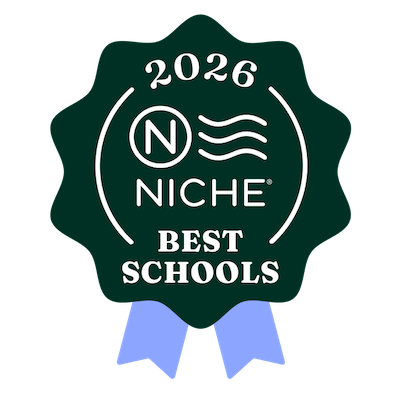Search
Strength in Numbers: A Look Inside Hopkins’ Math Research Seminar
For mathematicians, the nature of research, as described by Hopkins math teacher Dr. Joshua Zelinsky ’03, is much like finding lost keys. Instead of immediately looking in the dark, they often start by tackling similar, related problems where there’s already some “light”—information or existing solutions. Eventually, Zelinsky explains, with enough of these correlated solutions, “it will show you how to bring the light back to where you really want it.”
This approach—working on more tractable problems to illuminate a path toward a larger, unresolved one—is a key aspect of mathematical thinking. Students in the Math Research Seminar course at Hopkins, led by Zelinsky, explore an advanced mathematical topic and conduct original research with the hope of shedding light on a specific, unresolved problem. This intensive, yearlong seminar culminates in a semester-long intensive search for their own original mathematical findings, with the ultimate goal of achieving publication in a math journal.
A Passion for Mathematics
Seniors Richard Fearon III, Henry Foushee, Benjamin Porosoff, Alexander Skula, and Kyle Zhang were drawn to the 2024–2025 seminar group by their passion for mathematics, a curiosity for higher-level math, and the original research component the Math Research Seminar provides.
“I’ve always really enjoyed learning math at Hopkins and this class was the sequence after linear algebra, algebra, and multivariable calculus. So it was like, why not?” said Skula. “I’ve really enjoyed both learning higher level math and going through research such as this to gain experience in the process,” he added.
Foushee, too, jumped at the opportunity to join the seminar.
“After taking linear algebra and multivariable calculus last year, I had the choice not to continue with math, but I love math, so that wasn’t going to happen.”
The class allowed the students to explore mathematics beyond the standard curriculum and engage with a research process typically reserved for college or beyond.
The Search for Novelty
The Math Research Seminar is a one-year course that spans both semesters. In the first semester, students delve into advanced mathematical material. The second semester is dedicated to original research on a topic that no one in the mathematics world has yet solved, concluding with a final paper and journal submission. Zelinsky facilitates student-led discovery by offering two to five potential topics and providing students with guidance and assistance on writing the final paper, while they conduct the majority of the research.
For Zelinsky, one of the challenges is finding appropriate research topics that are unsolved but are also accessible to high school students and can be tackled in one semester of study.
“The Long Way”
In the 2024–2025 seminar group, the seniors learned number theory in the first semester. During the second semester, they built on previous work about “two near perfect numbers.” They were disproving a conjecture from earlier students in the 2022–2023 seminar, while simultaneously showing it was “almost correct” except for one family of exceptions.
With uncharted mathematical territory ahead and a serious deadline looming—graduating from Hopkins—the students faced many trials and tribulations to finish their project. The painstaking process included what the seniors described as “the long way”: revisiting and simplifying proofs to arrive at a result that significantly simplified all prior work. At one point, their notes document spanned over 40 pages of arithmetic.
“Some days it was hard because we didn’t feel like we made a lot of progress in one day, but some days we really felt like we had breakthroughs and that felt really great,” said Kyle Zhang. “Overall, the whole process turned out really well based on our expectations.”
Did you know?
Perfect numbers are a special type of number where the sum of their proper divisors (all the numbers that divide into it evenly, except for the number itself) adds up to the original number. In the case of two near perfect numbers, it means the sum of its proper divisors is short by exactly two, or it’s equal to the number plus or minus two.
Inspiring Future Discoveries
According to Zelinsky, although the students have since graduated, they are still working on the finalized project, with an anticipated completion date at the end of the summer. After fluctuating progress—incessant rewrites, drafts, and revisions—they hope to submit the research paper to Integers, an online math journal focused on research in number theory. The group is excited for the possibility of published work, something that could impact future mathematicians in their findings.
“I think it’ll be cool if after publishing it, other people will look at it and find some applications for it, build off of it, and find more cases,” said Porosoff while the rest of the group nodded eagerly. “We hope our work will be able to inspire others too,” he added.
When asked what the group was most looking forward to, Skula replied, “The satisfaction of proving something.” And with a nod to the mathematical heroes that came before them, he added, “Another hope is that this research might be useful in the future. The probability is very small, but that probability is non-zero. It exists, and maybe someday there will be use of two near-perfect numbers.”

Hopkins is a private middle school and high school for grades 7-12. Located on a campus overlooking New Haven, CT, the School takes pride in its intellectually curious students as well as its dedicated faculty and staff.
Hopkins School admits students of any race, color, national and ethnic origin to all the rights, privileges, programs, and activities generally accorded or made available to students at the school. It does not discriminate on the basis of race, color, national and ethnic origin in administration of its educational policies, admissions policies, scholarship and loan programs, and athletic and other school-administered programs.










